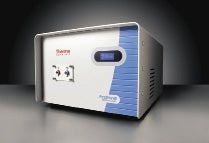Spectrometers designed by Massachusetts-based companies are unlocking answers to some of science’s greatest mysteries, making it easier for companies to spot potential problems with products ranging from drugs to medical devices.
“Experiments that didn’t seem possible 10 years ago are already being done today,” said Scott Shaffer, director of University of Massachusetts Medical School’s proteomics and mass spectrometry facility.
Technological advances, tighter regulation and increased production costs have resulted in soaring sales for spectrometers, laboratory devices used to identify and measure the amount of individual components that make up a substance.
The North American spectrometry market is expected to expand by nearly 13 percent annually between 2012 and 2017, with yearly revenue rising from $2.7 billion to $5.1 billion over that span, according to a report from Wellesley-based BCC Research. In 2010, North American sales were $2.1 billion.
3 industries lead in usage
This growth is being driven largely by increased spectrometry usage in the clinical research, environmental and food safety sectors, said Tina Settineri, director of hardware product marketing for the life science mass spectrometry division of Thermo Fisher Scientific, which has operations in Franklin. Academic purchases have declined, though, due to spending restraints that followed federal budget cuts triggered by sequestration.
Pharmaceutical and biotech companies make up the biggest share of the spectrometry market, BCC Research found, accounting for about 42 percent of the customer base. That will only continue to rise due to the sector’s robust financial backing and the growing need for new drugs, said Hans Dewald, a senior marketing manager for Framingham-based AB Sciex.
The latest technology increases the likelihood that drug companies will be able to fail drugs earlier in the development process, potentially saving millions of dollars if those same errors were not to be spotted until the clinical testing phase, said Brian Murphy, a spokesman for Milford-based Waters Corp.
Understanding molecules better and faster will help drug companies get their products to market more quickly, Dewald said.
“The more you know early on, the better off you are,” he said.
Nowadays, Murphy said any laboratory valuing accurate or precise results must have spectrometry in its toolkit.
“It is a technology that is no longer a luxury as it was in the 1980s,” he said.
Spectrometry dates back to the development of the atomic bomb during World War II, Shaffer said, but really took off in the late 1980s and early 1990s as the discovery that proteins could be ionized (that is, given a positive or negative charge) allowed for its use in life sciences.
But even into the 1990s, Shaffer said spectrometers were considered too expensive and specialized for use in hospitals or clinics. That’s no longer the case. “The data has emerged on the necessity of bringing this into the clinic,” he said.
The embrace of spectrometry is being fueled in large part by more intense oversight. Regulators do not consider improved patient health sufficient evidence that a particular drug is having a material, positive impact, Shaffer said.
“The FDA (U.S. Food and Drug Administration) wants real measurements that the drug is working,” he said.
Food safety rules have also gotten tougher as food imports continue to rise, Murphy said, driving demand for devices with better detection abilities.
The current generation of machines is far more effective at identifying small concentrations of molecules in the presence of huge concentrations of molecules, Murphy said. Even the smallest molecular concentration can affect reactions and alter the entire outcome of a drug study, he said.
In fact, Shaffer said many old experiments are being redone with the latest spectrometry machines to glean more insight.
The devices are also smaller and cheaper. Spectrometers used to be the size of a small refrigerator, weighing 1.5 tons and requiring a specialized laboratory away from the production facilities, said Mark Dixon, a nuclear magnetic resonance (NMR) product manager at Thermo Fisher.
Today, Thermo Fisher’s basic picoSpin model weighs just 40 pounds, which Dixon said makes it both the approximate size and weight of a small microwave. The picoSpin can also easily be transported to a site where materials are present, he said, which is often preferable to hauling whatever is being measured into the laboratory.
And Waters’ ionKey/MS system — which works in tandem with a mass spectrometer to facilitate more advanced research — is only the size of a small phone, Murphy said.
Lower price points
Prices have also plummeted in recent years for both spectrometers and supporting devices.
Lasers assisting mass spectrometry research cost just $50,000 today, down from $250,000 a half-decade ago, said Alessandra Fercozo, a junior fellow at Harvard University’s Rowland Institute.
And while the most sophisticated devices can cost nearly $1 million, most companies and institutions only turn to their spectrometer for simple computations, Dixon said.
The picoSpin is aimed at lower-end users. A more basic version, costing $27,000, is affordable enough for two-year colleges to stock in an undergraduate teaching laboratory.
“We’ve democratized the technology so that small companies can afford a machine,” Dixon said.

